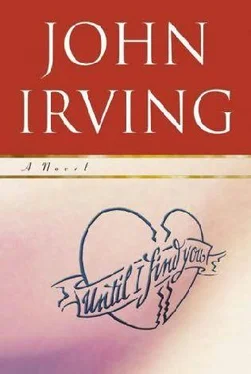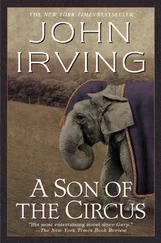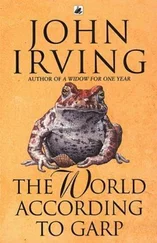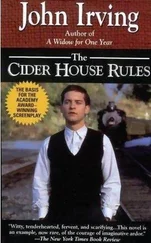“Oh, Jack,” Emma whispered in his ear—her incredibly soft upper lip brushing his neck. “We’re gonna have such a good time together.”
The arched doorways in the junior-school corridor made Jack Burns think of Heaven. (If there were a passageway to Heaven, Jack used to think, surely it would have arches like that.) And the black-and-gray triangles on the linoleum floors made him feel that school and the grown-up life after it was a game to be played—maybe a game he hadn’t yet been exposed to, but a game nonetheless.
Another game was the miniature, broken-window view of the playground from the second-floor washroom—it was the only boys’ washroom at St. Hilda’s. The frosted-glass windowpanes were small and framed in black-iron squares. One of the panes was broken; it remained unrepaired through Jack’s fourth-grade year. And the low urinals in the boys’ washroom were not quite low enough when he was in kindergarten. He needed to stand on tiptoe and aim high.
There were the infrequent but intimidating appearances in that second-floor hallway of those older girls who were boarders; one could gain access to their residence through the junior school. Only girls in grade seven and up were admitted to residency, and there were no more than one hundred boarders out of the five hundred girls in the middle and senior school. (St. Hilda’s was a city school—most of the students lived at home.)
The older girls who were boarders struck Jack as much older. Their detectable sullenness wasn’t limited to the daughters of diplomats or the other foreign students, nor was their gloom regional in nature—the cousins who were called “the Nova Scotia sluts” were as depressed as the girl from British Columbia whom Emma Oastler called “the B.C. bitch.” The boarders had about them a noticeable air of being banished. The boarders’ choir made the most mournful music in the school.
Sightings of the girls in residency were unusual in the junior school, but once, in his grade-three year, Jack was emerging from the boys’ washroom (still zipping up his fly), when he saw a couple of grade-thirteen girls striding toward him—a flash of nail polish, kneesocks rolled down to their ankles, shapely legs, wide hips, full breasts. Jack panicked. In his haste, his penis got snagged in his zipper. Naturally, he screamed.
“Sweet Jesus, it’s a boy !” one of the big girls said.
“I’ll say it is, and he’s caught his miserable thing in his zipper,” the other replied.
“When do they start playing with their things?” the first girl asked. “Stop screaming!” she said sharply to Jack. “You haven’t cut it off, have you?”
“Let me do that,” the second girl said, kneeling beside Jack. “I have a little brother—I know how to handle this.”
“You have to handle it?” the first girl asked. She knelt beside Jack, too.
“Let me see it—get your hands off the thing!” the girl with the little brother told Jack.
“It hurts !” Jack cried.
“You’ve just pinched some skin—it’s not even bleeding.” The girl was at least seventeen or eighteen—maybe nineteen.
“When does it get big?” the first girl asked.
“It doesn’t feel like getting big when it’s stuck in a zipper, Meredith.”
“It gets big when it feels like it?” Meredith asked.
The grade-thirteen girl held Jack’s penis in her hand; with the thumb and index finger of her other hand, she gently tugged at his zipper.
“Ow!”
“Well, what do you want me to do?” the girl who’d come to his assistance asked. “Wait for you to grow up?”
“You’ve got lady-killer eyelashes,” Meredith told Jack. “When you’re old enough, you’re going to get your penis stuck in all kinds of places.”
“Ow!”
“ Now it’s bleeding,” the second girl said. Jack was unstuck, but she went on holding his penis in her hand.
“What are you doing, Amanda?” Meredith asked.
“Just watch,” Amanda said. She didn’t mean for Jack to watch. Without looking, he could feel his penis getting big—or at least a little bigger.
“What’s your name?” Meredith asked him.
“Jack.”
“Feeling better, eh, Jack?” Amanda asked.
“Sweet Jesus, look at that thing!” Meredith said.
“That’s nothing,” Amanda said. “You can get bigger than that, can’t you, Jack?” He was as big as he’d ever been before. He was afraid that if he got any bigger, he would burst.
“It’s beginning to hurt again,” he said.
“That’s a different kind of pain, Jack.” Amanda gave him a friendly squeeze before she let him go.
“Better not catch that whopper in your zipper, Jack,” Meredith warned him. She stood up and ruffled his hair.
“Maybe you’ll dream about us, Jack,” Amanda said.
The cut on Jack’s penis healed in a couple of days, but those dreams didn’t go away.
Miss Sinclair, Jack’s kindergarten teacher, echoed Alice’s conviction that Jack would be safe with the girls. This illusion was further advanced by the participation of the grade-six girls in the kindergartners’ nap time. Emma Oastler was a volunteer, along with two other grade-six girls—Emma’s good friends Charlotte Barford and Wendy Holton. They were Miss Sinclair’s nap-time helpers. These older girls were supposed to assist five-year-olds in falling asleep; that they kept the kindergartners awake was closer to the truth.
Miss Sinclair was distinguished in Jack’s memory for her habit of condemning him to nap with three grade-six girls. What he remembered best about Miss Sinclair was her absence.
The naps began with what Emma Oastler called “a sleepy-time story.” Emma was always the storyteller, an early indication of her future calling. While Wendy and Charlotte circulated among the children, making sure that their rubber mats were comfortably rolled out, their blankets snugly wrapped around them, and their shoes off, Emma began her story in the semidark room.
“You’ve had a bad day, and you’re very tired,” Emma’s stories always began. For stories intended to induce sleep, they had the opposite effect—the kindergartners were too terrified to nap. In an oft-repeated classic among Emma Oastler’s nap-time tales, Miss Sinclair lost the entire kindergarten class in the bat-cave exhibit at the Royal Ontario Museum. In reality, Jack’s first school trip to the Royal Ontario Museum was led by his grade -three teacher, Miss Caroline Wurtz.
Miss Wurtz was the teacher Jack would remember most fondly, and not only for her fragile beauty; she was an important mentor for him in his early mastery of stage presence, another area in which she excelled. Miss Wurtz was a maven in the dramatic arts; in the innumerable school plays in which Jack performed at St. Hilda’s, she was usually his director. However, her talents as a classroom teacher were lacking in comparison to her theatrical gifts; control of the grade-three class eluded her. Offstage, out of the fixed glare of the footlights—either in her undisciplined classroom or in the marginally more lawless outside world—Miss Caroline Wurtz was an easily confused creature, bereft of confidence and without an iota of managerial skill.
On school trips, Miss Wurtz could have been a star in one of Emma Oastler’s sleepy-time stories—she was that inept. When she lost control of herself in the bat-cave exhibit at the Royal Ontario Museum, most of the grade-three kids were already suffering from total recall of Emma’s classic horror tale. (That they were then eight-year-olds, not five-year-olds, hardly mattered; the real-life circumstances were frighteningly familiar to the former kindergartners who’d first heard of the bat cave from Emma’s fiction.)
Читать дальше












